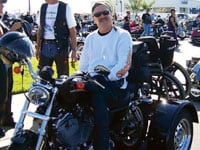
 ARNING! Heated car seats can be hazardous to your health.
ARNING! Heated car seats can be hazardous to your health.
Electric heated car seats are now commonplace. The idea sounds great: Hop in your car on a cold day, hit the seat heater switch, and luxurious heat warms and soothes you as you drive. But heated seats have been known to malfunction and become dangerously hot. For your average driver this isn’t a problem — if the seat starts to feel too warm, hit the off switch. But for people with paralysis or sensory deficit, this is the recipe for serious, possibly life-threatening burns.
Derek Johnson, an attorney for the Eugene, Ore., law firm of Johnson, Clifton, Larson and Schaller, has been representing people with paralysis who have been seriously burned. The firm has identified 63 people from various states who have suffered serious burns from heated seats. Considering there are hundreds of thousands of vehicles with heated seats in the United States, Johnson thinks the problem may be widespread.
Ron Devine of Sacramento, Calif., is one of Johnson’s clients. Devine, 54, has been a T10-11 paraplegic for 37 years. He prides himself on staying healthy and active.
In January 2006, Devine went out to dinner with his son, then drove home in his 1999 Chrysler Town & Country minivan. The vehicle came equipped with heated seats, but Devine never thought of using them. Somehow, the seat heater button got turned on. “I got home and was transferring into bed and saw two wet spots on my wheelchair cushion. Then I moved and saw two more wet spots where I had been sitting on the bed. I reached back and felt blisters on both sides of my rear and upper thigh. I was devastated,” recalls Devine.
Knowing he had a serious problem, he stayed in bed and called a home health care nurse to come and manage the burns until they were healed enough for him to travel to see a doctor and wound care specialist. Devine got lucky. He avoided serious infection and surgery. But it took him many months to heal, and now his skin is permanently compromised.
“I was very active, loved doing sports. I rode a custom Harley with a sidecar and was an avid water skier. The burn damage prevents me from doing these things ever again. I’m a tough guy and I will go on, but I’m really concerned about what happens five years from now when my arms weaken. What will happen to the damaged skin at that point [when transferring becomes more difficult]?
Johnson says that auto manufacturers knew about the problem but didn’t fix it. The National Highway Traffic Safety Association started an investigation in January 2001 after receiving complaints of heated car seats catching fire on 1999 Chrysler Town and Country minivans. NHTSA closed the investigation in June 2001 after Chrysler responded that the problem was solved because the seat materials are fireproof, there had been no treatment sought for injuries, “only dime size holes had been burned in the seat,” and “operators can turn the seat off at first sign of discomfort.”
But what if the operator lacks sensation below the waist?
The problem is by no means limited to Chrysler products. The list of complaints and/or recalls on heated seats includes many makes and models, e.g., including Chrysler, Ford, many General Motors products, Jeep, Mercedes Benz and Volvo.

Sally Ray of Silt, Colo., a full-time mother of two boys, ages 7 and 11, became a T7 incomplete para in April 2003. Following her injury, Ray and her husband purchased a 2000 Jeep Grand Cherokee because it is such a good vehicle for driving in snowy areas. Just before Thanksgiving 2007, only seven months after her accident, Ray was driving the Jeep from Silt to Grand Junction, about an hour-long drive. “I happened to look down at the center console and noticed the heater button for the seat had been engaged. I thought, wow, this feels really hot on my back, and turned it off.”
Ray spent the day in Grand Junction and drove home. The next morning, when her husband was helping roll her in bed, he noticed a large, popped blister about twice the size of a 50-cent piece on her butt in the area of her left ischial tuberosity — the bony prominence where most pressure sores occur. “At first I thought it was a bed sore, then I said, ‘James, the car seat got really hot,’ and he said, ‘Oh my gosh, it’s a burn.'”
They called Craig Hospital. Since James had done so well learning how to help Sally with her care, the doctor advised against the long trip to Craig. Instead she wrote up a list of how to care for the burn and called in prescriptions for the proper medications.
As the burn started to heal and the scab dropped off, it became apparent that the burn had gone deep into the muscle. “It was really tough. My kids were 2 and 6 at the time and I had to stay in bed on my side for five and a half months. I was lucky that my mom was able to come over and take care of the kids and make meals. And my husband’s job is flexible enough so he could come home long enough to turn me and change wound dressings.”
Ray’s doctors were very worried about infection, but thanks to good care from her husband, staying off the wound, and favorable luck, the wound healed. But there is still a big scar and a permanent indentation. The doctors at Craig say the skin integrity on the scar is only about 70 percent.
“I want people to know this can happen,” says Ray. I think the auto companies should put the seat heater controls in a place where they won’t get pushed accidentally and make it obvious when they are on.”
Johnson says his firm’s goal is not only to get fair compensation for burn victims, but also to cause manufacturers to fix defects and provide clear warnings of the possible dangers heated car seats pose. In each case Johnson has handled, the seats have malfunctioned and heated way beyond the maximum 100-105 degrees stated by the manufacturer’s service manual. A temperature of 111 degrees is hot enough to cause a burn, and 120 degrees is hot enough to cause a third degree burn in just 10 minutes. Some seats have measured as high as 150 degrees.

Chris Votoupal is a congressional aide, former RN, and dedicated snow skier from Denver. Votoupal is in his fourth year as a T9-10 complete paraplegic. After a day of skiing this past Christmas Eve, Votoupal loaded himself into the passenger seat of his friend’s 2003 Jeep Grand Cherokee Limited. As they started the two-hour drive back to Denver, Votoupal was cold, despite the thick long johns and Gore-Tex ski pants he was wearing, so he decided to turn on the heated car seat. After about an hour, he felt the seat with his hands and thought, “that’s pretty hot,” and turned it off.
When Votoupal arrived home, he got into the bathtub and felt something funny. He got out of the tub, grabbed a mirror and saw two big blisters, one on each side of his butt. He knew how serious this was and went to Craig Hospital’s wound care clinic for treatment. Four weeks later, despite constant care, the burns had gotten extremely serious. He went on bed rest and was advised to see a surgeon. On Feb. 5, he had skin grafts, and at press time, he remains on bed rest.
“Due to this burn I’m missing the best ski season Colorado has seen in 50 years. Plus, by not being able to sit, my life is seriously compromised,” says Votoupal.
Johnson has sound words of advice for those of us with paralysis or sensory deficit: “The risks of heated seats far outweigh the benefits. People should be made fully aware of the risk, and electric seat heaters should be disconnected.”
As fate would have it, not long ago I acquired a 1997 Jeep Grand Cherokee with all the options, including heated seats. I’ve been a T10 complete para for 23 years and the idea of heated seats being dangerous never occurred to me. Just recently I’ve been thinking how nice the warmth of the seat would feel on my back when I’m driving home from a day of skiing in the Lake Tahoe area.
Lucky for me, each time I drove home from skiing, I had the hot air cranked up, but forgot to push the seat heater button. This writing assignment landed on my desk the day before my next ski trip. I feel like I just dodged a bullet.
Support New MobilityWait! Before you wander off to other parts of the internet, please consider supporting New Mobility. For more than three decades, New Mobility has published groundbreaking content for active wheelchair users. We share practical advice from wheelchair users across the country, review life-changing technology and demand equity in healthcare, travel and all facets of life. But none of this is cheap, easy or profitable. Your support helps us give wheelchair users the resources to build a fulfilling life. |


Recent Comments
Kelly DeBardelaben on Tips to Maintain Bowel Regularity with SCI When You Travel
Glen Gregos on Traveling With and Without a Caregiver
Sue on Controller Recall Puts SmartDrive Safety in the Spotlight